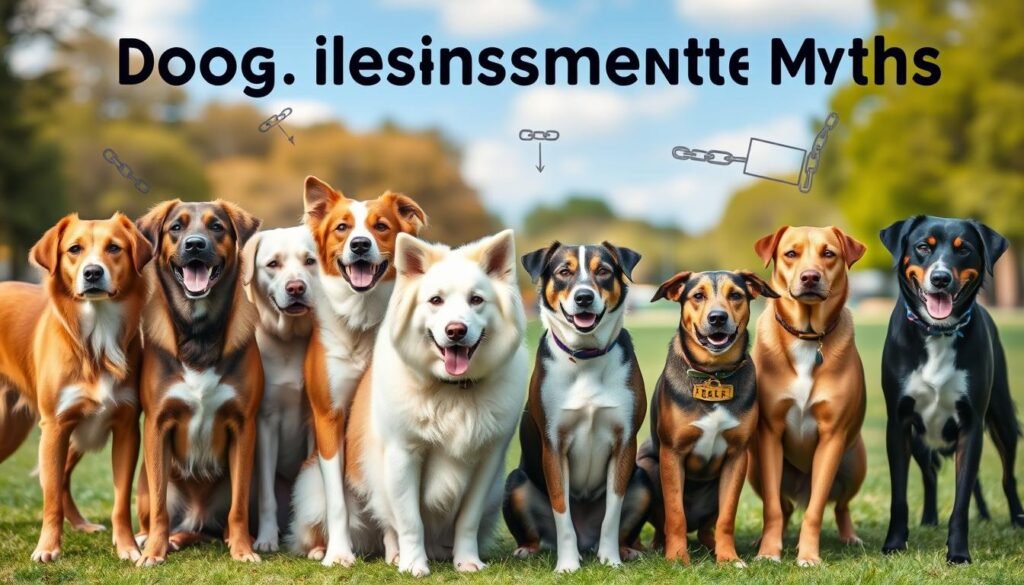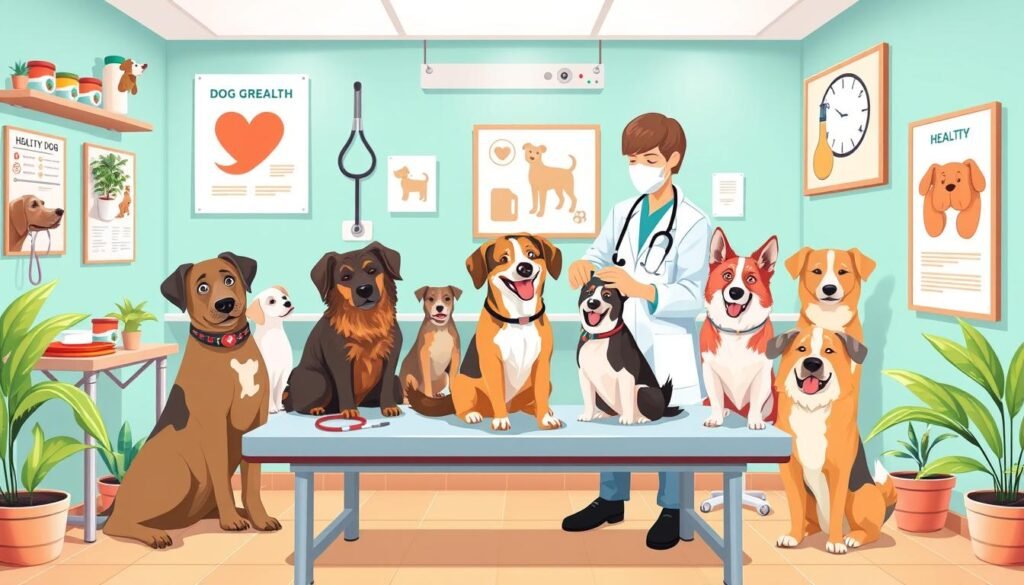Common Dog Insurance Myths Debunked: 7 Myths You Should Stop Believing
As a pet owner, have you ever believed false things about dog health and insurance? These myths can cause bad choices in caring for your pet and protecting them. But, what if I told you many of these beliefs are not true? It’s time to find out the truth behind common dog insurance myths.
Key Takeaways
- Less than 25% of dogs actually vomit after eating grass, debunking the belief that dogs do this to induce vomiting1.
- Up to 35% of pet owners underestimate the cost of their pets, challenging the misconception that cat health problems are less expensive to treat1.
- Nose temperature is not an accurate indicator of illness in pets, as it reflects the surrounding environment instead of health conditions1.
- A single adult female flea can lay up to 2,000 eggs, showing how common fleas are and why prevention is key1.
- Pets licking wounds can actually lead to infection because of bacteria in their mouths, proving licking does not help heal1.
Understanding Pet Insurance Basics

As a pet owner, knowing the basics of pet insurance is key. Unlike human health insurance, pet insurance works by reimbursing you after you pay vet bills2. It’s important to understand this to navigate the pet insurance world.
How Pet Insurance Actually Works
Pet insurance policies have deductibles, co-payments, and coverage limits2. You must pay a deductible before getting reimbursed. Co-payments are the part you pay for each bill. Knowing these details helps manage your costs and expectations.
Key Components of Pet Insurance Policies
Pet insurance policies can be customized to fit your needs2. Things like how many pets you have, their age, and health can affect your choice. This flexibility helps you find a policy that matches your budget and protects your pet.
The Reimbursement Process Explained
The reimbursement process involves sending claim forms and vet invoices to the insurance company3. Pet insurance doesn’t cover 100% of vet bills but can help a lot with emergencies or chronic conditions3. Knowing how it works helps you make better choices for your pet’s health.
In summary, pet insurance basics include a reimbursement model, key policy parts, customization, and the reimbursement process. Understanding these helps pet owners make smart choices and be ready for vet bills23.
The Truth About Pre-existing Conditions

As a pet owner, knowing about pre-existing conditions is key. These are health issues that existed before you got insurance. They are often not covered4. Common ones include chronic illnesses and genetic disorders that can affect dogs.
Even with pre-existing conditions, getting pet insurance is not a lost cause5. Some insurers might cover conditions that are “curable” after a certain time without symptoms. Also, most plans cover genetic and breed-specific conditions unless they were known before you signed up4.
Pet insurance doesn’t cover everything, like grooming or boarding4. It’s meant to help with unexpected vet bills, like accidents or new illnesses.
Knowing about pre-existing conditions and insurance limits helps you choose the right plan for your pet5. Talking to a trusted insurance provider can guide you to the best option for your budget and needs.
Enrolling your pet when they’re young and healthy is the best strategy6. This way, you avoid exclusions for pre-existing conditions. With the right policy, you can be sure your pet is protected from unexpected vet bills.
Dog Insurance Myths and Reality Check

There are many wrong ideas about dog insurance that can confuse pet owners. It’s important to know the truth to protect your pet well. Let’s clear up some common myths and see what pet insurance really offers.
Common Misconceptions About Coverage
Many think dog insurance covers all vet bills. But, most policies have limits, exclusions, and waiting times. Pre-existing conditions and some breed-specific issues are often not covered.7
Another myth is that coverage starts right after you buy a policy. Actually, most pet insurance has a waiting period, usually 14 to 30 days. This helps ensure pets are covered when they need it most.
Facts vs Fiction in Pet Insurance Claims
Some pet owners think filing claims is easy. But, it often needs detailed paperwork and can be denied for many reasons.8 Knowing how claims work and why they might be denied is key.
Trupanion is different because it pays vets directly, so you don’t have to pay first and then get reimbursed.8 Also, Trupanion doesn’t have payout limits. They covered a puppy’s vet bills over $57,000 when it was just under a year old8.
By understanding the truth about dog insurance, you can better protect your pet. This way, they get the care they need.
Cost Considerations and Premium Factors

Understanding the cost of pet insurance is key. Monthly premiums can be between $25 and $70 for dogs and $10 to $40 for cats. These costs vary based on several factors like coverage type, pet’s age, and location9.
It’s important to know about waiting periods for certain conditions or treatments. This is why asking about these periods is vital when choosing a plan9. Other factors like age, breed, and location also affect insurance rates9.
Deductibles and reimbursement rates are similar to human health insurance. They decide how much you pay out of pocket and how much the insurance covers9. Reading customer reviews can also help understand the insurance company’s reputation and service quality9.
Pet insurance can help with unexpected vet bills. But, it’s important to weigh the costs of premiums against the benefits. Knowing these factors helps pet owners choose the best insurance for their pets10.
“Pet insurance helps pet parents, demonstrates love for their pet, shows responsibility as a pet parent, and helps avoid painful choices about withholding care due to financial considerations.”10
Breed Restrictions and Coverage Limitations

Pet insurance can have breed restrictions and coverage limits. These rules are based on a breed’s risk level. This includes factors like bite incidents and claims history1112.
Understanding Breed-Specific Policies
Insurance companies often list “high-risk” dog breeds. These include Pit Bulls, Rottweilers, and German Shepherds12. These policies can affect your coverage, so it’s key to know the provider’s breed list.
Some companies, like State Farm and USAA, cover even risky breeds11. This shows the value of comparing policies to find the best one for your dog.
Coverage Options for Different Breeds
Don’t think your dog’s breed means no coverage. Some providers might offer exceptions if your dog is well-trained and well-behaved12. This could mean showing proof of training and good ownership.
Renters insurance can also help with liability for dog incidents. But, it might have breed limits based on bite and claim history12.
Knowing about breed policies and coverage can help you choose the right insurance. This way, you can protect your dog1112.
Age Requirements and Senior Pet Coverage

As our dogs get older, finding the right pet insurance can be tricky. Many companies won’t insure very young or senior dogs13. For example, Trupanion will cover senior dogs if you sign up before they turn 1413.
But, insurance for older pets might be more expensive or limited. This is because older dogs face more health problems.
Some companies offer special plans for senior pets. These plans have different coverage and costs13. Trupanion, for instance, covers 90% of costs after you meet the deductible. This is more than most companies, which usually cover 80%13.
Trupanion also doesn’t have an annual limit. This means you can get the best care for your pet without worrying about costs13.
Dog owners should know about age limits in insurance policies131415. As dogs get older, they face more health issues like cancer and kidney disease1415. Knowing about senior pet coverage helps owners make the best choices for their pets.
| Pet Age | Senior Stage |
|---|---|
| Small Breeds | 11-12 years |
| Medium Breeds | 10 years |
| Large Breeds | 8 years |
| Giant Breeds | 7 years |
The table shows that senior age varies by breed size. Smaller breeds usually reach senior age later than larger ones15. Knowing this helps owners choose the right insurance for their pets.
Insurance for senior dogs might cost more because of health risks15. But, a good senior pet plan can give peace of mind and access to needed care. By understanding pet insurance, owners can make choices that keep their pets healthy and happy.
Preventive Care Coverage Explained

Preventive care coverage is an extra option for pet insurance. It includes services like vaccinations and dental cleanings. It aims to keep pets healthy and might save money in the long run16. But, it really depends on your pet’s needs and the plan you choose17.
Wellness Plans and Routine Care
Wellness plans cover important preventive care like annual exams and dental cleanings18. They help pet owners plan for their pet’s health needs16. It’s key to think about your pet’s needs and the plan’s value when choosing.
Vaccination and Check-up Coverage
Vaccinations and regular check-ups are key to preventive care18. Insurance that covers these helps keep pets healthy and catches problems early16. This can save money on bigger health issues later.
For pet owners, preventive care is a big deal161718. Investing in wellness plans can keep pets healthy and save money. It’s a smart choice for pet care.
Understanding Claims Processing and Reimbursement
The claims process for pet insurance can seem tough, but it’s easier than you think19. Pet insurance plans often get more expensive as pets get older. Some plans can increase by up to 700% by the time the pet is 10 years old19. But, some companies like Trupanion offer lifetime policies. They aim to help by covering about 71 cents of every dollar spent on vet bills19.
To start the claims process, you need to send in vet records and bills to your insurance20. How long it takes to get reimbursed can vary. But, some companies have apps or online portals to make it easier20. Trupanion, for example, offers 24/7 customer service, making it easier to get help when you need it20.
It’s important to know how the claims process works to manage pet care costs19. Trupanion has paid out nearly $1 billion to vets directly and over $2.5 billion in claims19. They don’t have payout limits, so pet owners don’t have to worry about unexpected vet bills20.
| Metric | Trupanion |
|---|---|
| Veterinary invoices paid directly to vets in 2014 | Nearly $1 billion19 |
| Total veterinary claims paid | Over $2.5 billion, increasing by $1.5 million daily19 |
| Payout for a puppy under one year in a single claim | $57,044.5720 |
Knowing how the claims process works helps pet owners choose the right insurance. It ensures their pets get the care they need without financial stress20.
Multi-Pet Discounts and Family Plans
Insuring multiple pets can save a lot of money. Many insurance providers offer discounts for pet owners with more than one pet. Companies like Figo Pet Insurance, Lemonade Pet Insurance, and Pumpkin Pet Insurance give discounts from 5% to 10% for multiple pets21.
These savings can help make pet insurance more affordable. This is great for families with many pets.
Some insurers, like Bow Wow Meow Pet Insurance, offer a 10% discount for each additional pet22. Family plans can also be a smart choice. They cover all pets under one policy, often at a lower cost than individual plans.
These plans let you customize coverage for each pet. This way, every pet gets the care it needs.
It’s important to compare individual policies and family plans. This helps find the best and most affordable option for your pets. By using multi-pet discounts and family plans, you can protect your pets while saving money2122.
FAQ
What are some common myths about pet health and insurance?
Many pet owners think a dry or warm nose means illness. They also believe purring always means a cat is happy. Wagging tails don’t always mean a dog is happy. Indoor cats don’t need flea prevention, and declawing cats is harmless. It’s important to know the truth about these myths to take good care of your pets and make smart insurance choices.
How does pet insurance work, and what are the key components of a policy?
Pet insurance works differently than human health insurance. You pay vet bills first and then get reimbursed. Important parts of a policy include deductibles, co-payments, and coverage limits. To get reimbursed, you need to send in claim forms and vet invoices to the insurance company.
How do pre-existing conditions affect pet insurance coverage?
Pre-existing conditions are usually not covered by pet insurance. These are health issues that existed before you got the policy. Common examples include chronic illnesses and hereditary disorders. It’s key to know how insurers define and handle these conditions to avoid surprises.
What are some common misconceptions about dog insurance?
Some think all vet expenses are covered, or you get coverage right away. But, most policies have waiting periods and exclude certain conditions. Breed-specific exclusions can also exist. Knowing the truth about claims and what’s covered is important for making good choices.
What factors influence pet insurance premiums?
Several things affect pet insurance costs, like the pet’s age, breed, and where you live. Older pets and certain breeds often cost more. Deductibles and coverage limits also play a role. It’s good to weigh the costs of premiums against the benefits when deciding on coverage.
How do breed-specific policies and limitations work in pet insurance?
Some insurers have special rules for certain breeds due to health risks. This might mean higher premiums or exclusions for hereditary conditions. It’s important to research these policies to find the best coverage for your pet.
What are the age requirements and coverage options for senior pets?
Many policies don’t cover very young or very old pets. Coverage for seniors might be limited or expensive. Some insurers offer special plans for older pets. It’s good to know about age-related policy limits and the value of insuring older pets.
What is preventive care coverage, and how does it work?
Preventive care coverage is an add-on for routine services like vaccinations and dental cleanings. These plans aim to reduce health costs over time. But, the value depends on your pet’s needs and the plan’s offerings. It’s important to compare costs and benefits before deciding.
How does the claims process for pet insurance work?
To file a claim, you need to send vet records and invoices to the insurer. Reimbursement times vary, and some insurers pay vets directly. Understanding the claims process is key for pet owners. Some insurers have apps or online portals to help with claims.
What are the benefits of multi-pet discounts and family plans?
Many insurers offer discounts for households with multiple pets. These can save a lot on premiums. Family plans cover all pets under one policy, often with more benefits. It’s wise to compare individual policies and family plans to find the best deal for your pets.
Source Links
- 9 Pet Health Myths You Should Stop Believing
- Debunking Pet Insurance Myths | ASPCA Pet Health Insurance
- Common Pet Insurance Myths
- Pet Insurance For Pre-Existing Conditions
- Top 5 Pet Insurance Myths Debunked
- The Truth Unleashed: Dispelling Pet Insurance Myths
- Pet insurance for dogs: 3 major myths debunked
- 5 Myths About Pet Insurance Debunked
- Factors to Consider Before Purchasing Pet Insurance – Creature Comforts Veterinary
- The Truth About Pet Health Insurance | ASPCA® Pet Health Insurance
- What Dog Breeds Affect Homeowners Insurance?
- What Banned Dog Breeds Won’t Insurance Cover?
- Pet Insurance for Your Senior Dog – Is it Worth it?
- Is Pet Insurance for Older Dogs Worth It? | MetLife Pet Insurance
- Pet Insurance for Older Dogs & Cats
- Survey: Most Pet Owners Who Have Pet Insurance Say It’s Worth the Cost – Experian
- Busting myths around pet insurance | RSPCA Pet Insurance
- 8 Pet Insurance Myths That Could Be Costing You | Knose
- De-mystifying Pet Insurance: An inside Look from Trupanion
- 5 Myths About Pet Insurance Debunked
- Best Multi-Pet Insurance Companies of December 2024: Compare Benefits, Discounts & Coverage Limits
- Affordable Pet Insurance for Multiple Pets: A Complete Guide
editor's pick
latest video
news via inbox
Nulla turp dis cursus. Integer liberos euismod pretium faucibua

